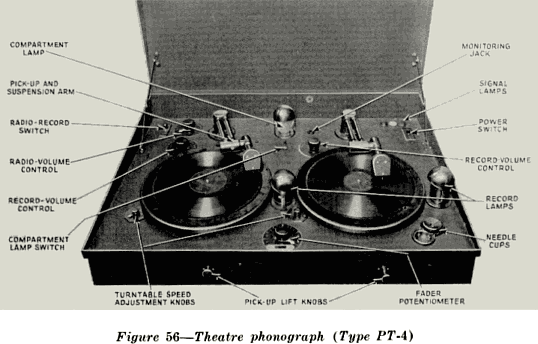The selector switch just mentioned can be used for converting the equipment instantaneously to the special use of amplifying either a radio program or some other special program. For ordinary use, the selector switch is in the center or "Record" position.
Fading from one turntable to the other is accomplished by turning the fader potentiometer so that its indicator points toward the table from which sound is desired.
The speed regulators are for adjusting the records to operate at the proper speed, which is 78 revolutions per minute.
Pick-up lift knobs are provided for use when it is desirable to make quick change-over from one record to the other. The pick-ups are lifted from the record when the knob is pushed in. The pick-up can be set over the record in any desired position and lowered by pulling out on the lift knobs. This can be done with one hand, leaving the other free for operating the fader potentiometer.
The other type of theatre phonograph in a steel case containing a twin turntable (PT-5) is similar to that just described, the chief differences lying in the construction of the cabinet.
Both of these types are equipped with amplifiers, as described in section 142, and, together with loudspeaker units, are known as the PG-17 and PG-18 equipments respectively.
77. Type PT-1 Non-Synchronous Twin Turntables. - The Type PT-1 has a wooden case and is shown in Figure 57. It consists of two electric turntables of 78 r.p.m., one fader switch, one "Radio-Record" switch, one "Short-Play" switch and a record light. The top is on hinges and may be removed when desired. At the rear is a binding post panel providing connections for the record output and radio input. The "Radio-Record" switch should be in the "Record" position and the "Short-Play" switch should be in the "Play" position for record reproduction. To transfer to radio reproduction the "Radio-Record" switch should be placed in the "Radio" position. By placing the "Short-Play" switch in the "Short" position, either the radio or record output may be monitored without sound reproduction from the speakers by plugging headphones into the monitoring jack.
7

